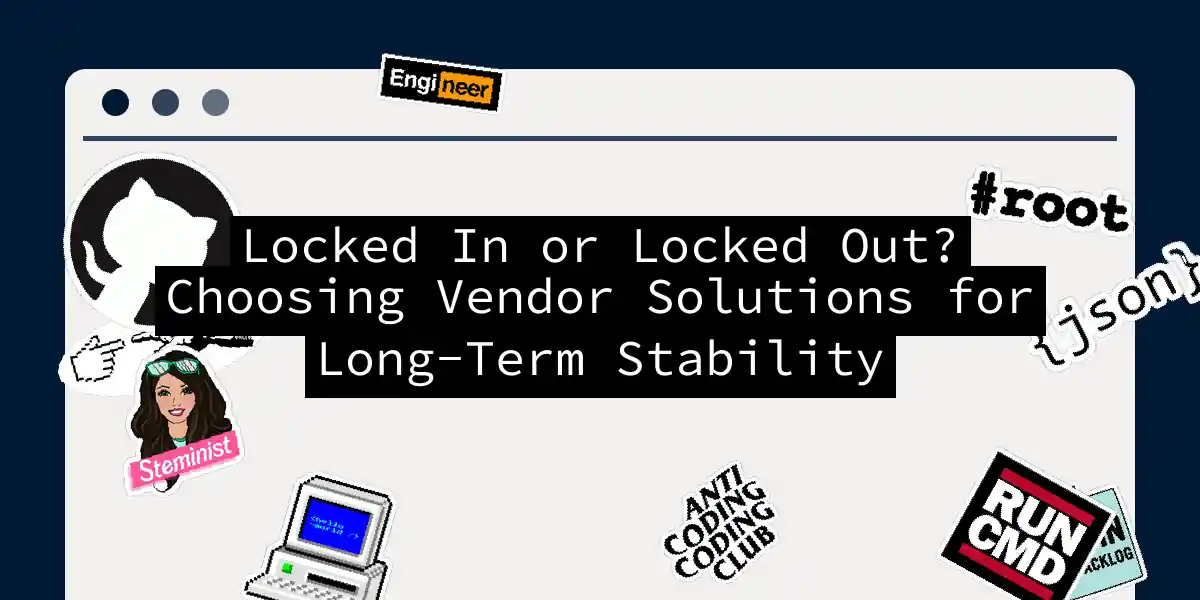Picture this: you’re at a tech buffet, piling proprietary sauce onto your infrastructure plate. It tastes great… until you realize you’ve glued your fork to the vendor’s hand. That’s vendor lock-in – the digital equivalent of wearing someone else’s shoes home after a party. You can walk, but every step feels awkwardly expensive. Let’s dissect how to avoid becoming a prisoner of your tech stack while keeping systems stable enough to survive a zombie apocalypse.
Why Vendor Lock-In is Tech’s Slow-Boil Frog Problem
It starts innocently enough. Vendor A offers shiny tools with “introductory pricing” (translation: tech’s version of a first-date discount). Before you know it, you’re rebuilding entire workflows around their proprietary quirks. The costs? Oh, they’re coming – like a surprise tax audit wrapped in a termination notice. Real-world fallout includes:
- Cost tsunamis: 70% price hikes when renegotiation time hits
- Innovation handcuffs: Watching competitors zip by while your vendor’s glacial update cycle moves at sloth-speed
- Migration nightmares: Like disentangling Christmas lights after storing them in a blender
“Vendors excel at cultivating lock-in like gardeners growing prize-winning dependency weeds” – and they’re always the winners at harvest season.
Your Escape Plan: Practical Anti-Lock Strategies
Don’t just whack the lock with a spoon. Here’s your multi-tool:
1. Architect for Defection (Like a Tech Spy)
Build exit ramps before you need them. Containerization is your friend:
# Dockerfile escape pod
FROM openjdk:17-alpine
EXPOSE 8080
COPY target/*.jar app.jar
ENTRYPOINT ["java","-jar","/app.jar"]
Pair this with Kubernetes manifests. If your app runs in any cloud without vendor-specific incantations, you’ve won half the battle.
2. The Abstraction Layer Forcefield
Wrap vendor services in your own code. Think of it as putting cling wrap on their banquet – you get the nutrients without staining your plate.
# payment_service.py - The Swiss Army knife approach
class PaymentProcessor:
def __init__(self, provider):
self.provider = provider
def charge(self, amount):
if self.provider == "VendorA":
return _vendor_a_charge(amount)
elif self.provider == "VendorB":
return _vendor_b_charge(amount)
# Add new providers without changing consuming code
3. Data Sovereignty Over Savior Complexes
Your data shouldn’t need a visa. Always:
- Use open formats (Parquet > proprietary binary blobs)
- Implement regular data emigration drills – test backups by restoring to different environments
- Encrypt at rest with your keys (not the vendor’s “we’ll hold these for you” trap)
-- SQL data liberation protocol
COPY (SELECT * FROM critical_table)
TO 's3://my-bucket/escape-hatch/'
WITH (FORMAT parquet, COMPRESSION snappy);
4. The Vendor Vetting Hunger Games
When evaluating providers, bring this checklist:
| Lock-In Risk | Low-Risk Sign | Red Flag |
|--|--|--|
| **Data Portability** | Export APIs with 1 click | "Contact sales for exit" |
| **Customization** | Webhooks/APIs everywhere | "Our magic black box™" |
| **Pricing** | Transparent calculator | "Enterprise-only" tiers |
| **Standards** | OpenAPI specs available | "Our special SDK" required|
The Custom Development Wildcard
Sometimes the only winning move is to build your own chessboard. Custom development isn’t for every feature – reserve it for your crown jewels. The ROI sweet spot? When:
- Your differentiator depends on it (e.g., Tesla building their battery software)
- Compliance needs are unicorn-level unique
- Vendor licensing costs would fund a small moon mission
Pro tip: Treat vendors like fire extinguishers – critical for specific emergencies, but you wouldn’t build your house inside one.
The Stability Paradox
Ironically, the most “stable” vendor relationships are those you can destabilize on your terms. True system stability comes from:
- Portability muscles: Regularly lift your workloads between environments
- Vendor polyamory: Never put all critical path eggs in one basket
- Contractual prenups: “If we break up, I keep the data kids” The moment a vendor says “You can’t do that without our platform,” hear it as a fire alarm. Your exit plan isn’t a disaster recovery step – it’s recovery’s architect. So, are you building a tech stack or a prison cell? The difference is how quickly you can pack your data bags and leave. Choose solutions that treat your infrastructure like a rental, not a marriage – sometimes divorce is stability.
*Tagged: #vendor-lock-in #cloud-strategy #enterprise-architecture*
*Next week: "When Technical Debt Collectors Come Knocking: Paying Down Your Code Mortgages"*
